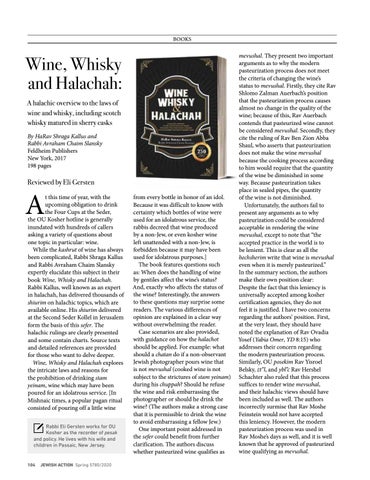BOOKS
Wine, Whisky and Halachah: A halachic overview to the laws of wine and whisky, including scotch whisky matured in sherry casks By HaRav Shraga Kallus and Rabbi Avraham Chaim Slansky Feldheim Publishers New York, 2017 198 pages
Reviewed by Eli Gersten
A
t this time of year, with the upcoming obligation to drink the Four Cups at the Seder, the OU Kosher hotline is generally inundated with hundreds of callers asking a variety of questions about one topic in particular: wine. While the kashrut of wine has always been complicated, Rabbi Shraga Kallus and Rabbi Avraham Chaim Slansky expertly elucidate this subject in their book Wine, Whisky and Halachah. Rabbi Kallus, well known as an expert in halachah, has delivered thousands of shiurim on halachic topics, which are available online. His shiurim delivered at the Second Seder Kollel in Jerusalem form the basis of this sefer. The halachic rulings are clearly presented and some contain charts. Source texts and detailed references are provided for those who want to delve deeper. Wine, Whisky and Halachah explores the intricate laws and reasons for the prohibition of drinking stam yeinam, wine which may have been poured for an idolatrous service. [In Mishnaic times, a popular pagan ritual consisted of pouring off a little wine Rabbi Eli Gersten works for OU Kosher as the recorder of pesak and policy. He lives with his wife and children in Passaic, New Jersey.
104
JEWISH ACTION Spring 5780/2020
from every bottle in honor of an idol. Because it was difficult to know with certainty which bottles of wine were used for an idolatrous service, the rabbis decreed that wine produced by a non-Jew, or even kosher wine left unattended with a non-Jew, is forbidden because it may have been used for idolatrous purposes.] The book features questions such as: When does the handling of wine by gentiles affect the wine’s status? And, exactly who affects the status of the wine? Interestingly, the answers to these questions may surprise some readers. The various differences of opinion are explained in a clear way without overwhelming the reader. Case scenarios are also provided, with guidance on how the halachot should be applied. For example: what should a chatan do if a non-observant Jewish photographer pours wine that is not mevushal (cooked wine is not subject to the strictures of stam yeinam) during his chuppah? Should he refuse the wine and risk embarrassing the photographer or should he drink the wine? (The authors make a strong case that it is permissible to drink the wine to avoid embarrassing a fellow Jew.) One important point addressed in the sefer could benefit from further clarification. The authors discuss whether pasteurized wine qualifies as
mevushal. They present two important arguments as to why the modern pasteurization process does not meet the criteria of changing the wine’s status to mevushal. Firstly, they cite Rav Shlomo Zalman Auerbach’s position that the pasteurization process causes almost no change in the quality of the wine; because of this, Rav Auerbach contends that pasteurized wine cannot be considered mevushal. Secondly, they cite the ruling of Rav Ben Zion Abba Shaul, who asserts that pasteurization does not make the wine mevushal because the cooking process according to him would require that the quantity of the wine be diminished in some way. Because pasteurization takes place in sealed pipes, the quantity of the wine is not diminished. Unfortunately, the authors fail to present any arguments as to why pasteurization could be considered acceptable in rendering the wine mevushal, except to note that “the accepted practice in the world is to be lenient. This is clear as all the hechsherim write that wine is mevushal even when it is merely pasteurized.” In the summary section, the authors make their own position clear: Despite the fact that this leniency is universally accepted among kosher certification agencies, they do not feel it is justified. I have two concerns regarding the authors’ position. First, at the very least, they should have noted the explanation of Rav Ovadia Yosef (Yabia Omer, YD 8:15) who addresses their concern regarding the modern pasteurization process. Similarly, OU posekim Rav Yisroel Belsky, zt”l, and ybl”c Rav Hershel Schachter also ruled that this process suffices to render wine mevushal, and their halachic views should have been included as well. The authors incorrectly surmise that Rav Moshe Feinstein would not have accepted this leniency. However, the modern pasteurization process was used in Rav Moshe’s days as well, and it is well known that he approved of pasteurized wine qualifying as mevushal.
